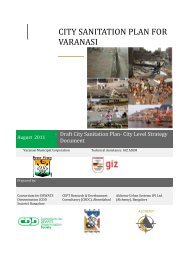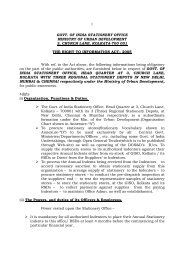CITY SANITATION PLAN - Ministry of Urban Development
CITY SANITATION PLAN - Ministry of Urban Development
CITY SANITATION PLAN - Ministry of Urban Development
You also want an ePaper? Increase the reach of your titles
YUMPU automatically turns print PDFs into web optimized ePapers that Google loves.
<strong>CITY</strong> <strong>SANITATION</strong> <strong>PLAN</strong> BAREILLY<br />
improvement on the old supply driven approach, the pure demand-responsive approach is also<br />
inadequate in a number <strong>of</strong> respects.<br />
It is based on what intended service users know, thus limiting scope for change and<br />
innovation.<br />
It ignores the fact that service users are likely to be concerned only with their immediate<br />
surroundings, so that demand for local improvements may be at the expense <strong>of</strong> the wider<br />
environment.<br />
In equating demand with willingness to pay, it perhaps overlooks the fact that the main<br />
problem may be either that sanitation providers are unwilling to charge users for the full<br />
cost <strong>of</strong> services, or that poor people are unable to pay for the full cost <strong>of</strong> the services.<br />
It fails to pay sufficient attention to the capacity <strong>of</strong> service deliverers to respond to demand.<br />
This is a particularly important point where existing service delivery systems are weak.<br />
The market correlation approach<br />
The approach assumes that sanitation is a commodity that should be sold like any other commodity,<br />
for instance a car. People should therefore be <strong>of</strong>fered a range <strong>of</strong> sanitation options from which they<br />
can choose. This approach has two basic drawbacks:<br />
It assumes that individual sanitation users can act independently <strong>of</strong> one another with each<br />
achieving the optimum result for him or her. In practice, this is rarely the case and people<br />
need to act together if the best results are to be achieved.<br />
It ignores the fact that different stakeholders may have different objectives. There is a real<br />
danger that the choices <strong>of</strong> community members will relate to their immediate needs and<br />
ignore the wider environmental implications <strong>of</strong> their sanitation choices.<br />
The user knows best approach<br />
This approach assumes that sanitation-related choices should be based solely on user preferences<br />
and that the role <strong>of</strong> pr<strong>of</strong>essionals is to facilitate those choices. It underestimates the value <strong>of</strong><br />
'pr<strong>of</strong>essional' knowledge. Like the market analogy approach, it assumes that all stakeholders have<br />
the same priorities and will act as a coherent group at the local level. These weaknesses mean that<br />
the approach encourages local ad-hoc activity at the expense <strong>of</strong> overall planning. For example;<br />
ADMINISTRATIVE STAFF COLLEGE OF INDIA, HYDERABAD Page 172
















